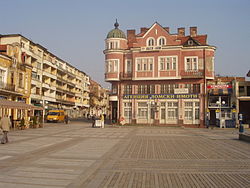Lom, Bulgaria
|
Lom Лом |
||
|---|---|---|
 |
||
|
||
| Location of Lom, Bulgaria | ||
| Coordinates: 43°49′32″N 23°14′15″E / 43.82556°N 23.23750°ECoordinates: 43°49′32″N 23°14′15″E / 43.82556°N 23.23750°E | ||
| Country | Bulgaria | |
|
Province (Oblast) |
Montana | |
| Government | ||
| • Mayor | Penka Penkova | |
| Area | ||
| • Total | 52.203 km2 (20.156 sq mi) | |
| Elevation | 20 m (70 ft) | |
| Population (2009-12-31) | ||
| • Total | 24,300 | |
| Time zone | EET (UTC+2) | |
| • Summer (DST) | EEST (UTC+3) | |
| Postal Code | 3600 | |
| Area code(s) | 0971 | |
| Website | Official website | |
Lom (Bulgarian: Лом) is a town in northwestern Bulgaria, part of Montana Province, situated on the right bank of the Danube, close to the estuary of the Lom River. It is the administrative centre of the eponymous Lom Municipality. The town is 162 km (101 mi) north of Sofia, 56 km (35 mi) southeast of Vidin, 50 km (31 mi) north of Montana and 42 km (26 mi) west of Kozloduy. It is the second most important Bulgarian port on the Danube after Rousse. As of December 2009, the town has a population of 24,300.
Lom was founded by the Thracians under the name of Artanes in Antiquity. After them the Romans called the fortress and the town Almus, from where the name of the today's city and of the Lom River comes.
There are no reports proving that there existed a big settlement in the Middle Ages. It was not until Ottoman rule that it enlarged but for a long time it was under the shadow of the dominant towns of Vidin, Nikopol and Silistra. It is assumed that the Ottoman village was founded in 1695 by Kara Mustafa and Murad Bey, who were defeated at Vienna in 1683 and who came here sailing rafts along the Danube.
The name Lom Palanka was mentioned for the first time in 1704. The settlement then called Palanka stood between village and town in size and importance. In 1798 Lom suffered from brigand raids. With the development of shipping along the Danube after 1830, the importance of the town grew. The road to Sofia contributed to its progress and turned it into a main export port to Vienna (Austria). By 1869 there were 120 shops, 148 trade offices, 175 food shops, 34 coffee bars, six hotels and two mills. The town was centred on the old Kale (fortress), which was entered through three kapii (gates) — Vidinska, Belogradchishka, Sofiyska. The tradesmen from Lom offered goods at the biggest fairs in the region and beyond. In 1880 there were 7,500 inhabitants in the town.
...
Wikipedia


